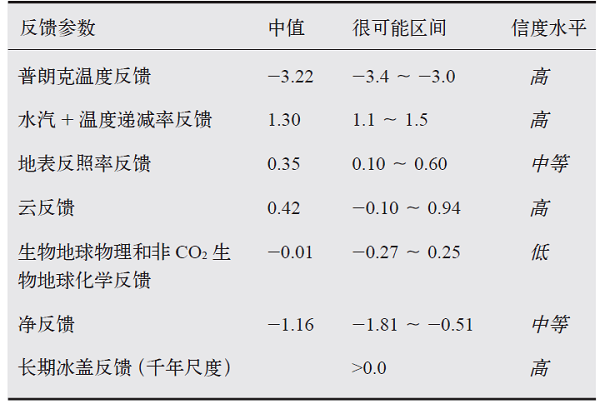| [1] |
Brown P T, Li W, Li L, et al. Top-of-atmosphere radiative contribution to unforced decadal global temperature variability in climate models[J]. Geophysical Research Letters, 2014, 41(14): 5175-5183
doi: 10.1002/2014GL060625
URL
|
| [2] |
Palmer M D, McNeall D J. Internal variability of Earth’s energy budget simulated by CMIP5 climate models[J]. Environmental Research Letters, 2014, 9(3): 034016
doi: 10.1088/1748-9326/9/3/034016
URL
|
| [3] |
Trenberth K E, Fasullo J T, Balmaseda M A. Earth’s energy imbalance[J]. Journal of Climate, 2014, 27(9): 3129-3144
doi: 10.1175/JCLI-D-13-00294.1
URL
|
| [4] |
von Schuckmann K, Palmer M D, Trenberth K E, et al. An imperative to monitor Earth’s energy imbalance[J]. Nature Climate Change, 2016, 6(2): 138-144
doi: 10.1038/nclimate2876
URL
|
| [5] |
IPCC. Climate change 2021: the physical science basis [M/OL]. 2021 [2021-08-09]. https://www.ipcc.ch/report/ar6/wg1/downloads/report/IPCC_AR6_WGI_Chapter_07.pdf
|
| [6] |
Devaraju N, Bala G, Nemani R. Modelling the influence of land-use changes on biophysical and biochemical interactions at regional and global scales[J]. Plant, Cell & Environment, 2015, 38(9): 1931-1946
|
| [7] |
Meraner K, Mauritsen T, Voigt A. Robust increase in equilibrium climate sensitivity under global warming[J]. Geophysical Research Letters, 2013, 40(22): 5944-5948
doi: 10.1002/grl.v40.22
URL
|
| [8] |
Caballero R, Huber M. State-dependent climate sensitivity in past warm climates and its implications for future climate projections[J]. Proceedings of The National Academy of Sciences, 2013, 110(35): 14162
doi: 10.1073/pnas.1303365110
URL
|
| [9] |
Rugenstein M, Bloch-Johnson J, Gregory J, et al. Equilibrium climate sensitivity estimated by equilibrating climate models [J]. Geophysical Research Letters, 2020, 47 (4): e2019GL083898
|
| [10] |
Zhu J, Poulsen C J, Tierney J E. Simulation of Eocene extreme warmth and high climate sensitivity through cloud feedbacks [J]. Science Advances, 2019, 5 (9): eaax1874
|
| [11] |
Sherwood S C, Webb M J, Annan J D, et al. An assessment of Earth's climate sensitivity using multiple lines of evidence [J]. Reviews of Geophysics, 2020, 58 (4): e2019RG000678
|
| [12] |
Jonko A K, Shell K M, Sanderson B M, et al. Climate feedbacks in CCSM3 under changing CO2 forcing. Part II: variation of climate feedbacks and sensitivity with forcing[J]. Journal of Climate, 2013, 26(9): 2784-2795
doi: 10.1175/JCLI-D-12-00479.1
URL
|
| [13] |
Mauritsen T, Bader J, Becker T, et al. Developments in the MPI-M Earth System Model version 1.2 (MPI-ESM1.2) and its response to increasing CO2[J]. Journal of Advances in Modeling Earth Systems, 2019, 11(4): 998-1038
doi: 10.1029/2018MS001400
pmid: 32742553
|
| [14] |
Duan L, Cao L, Caldeira K. Estimating contributions of sea ice and land snow to climate feedback[J]. Journal of Geophysical Research: Atmospheres, 2019, 124(1): 199-208
doi: 10.1029/2018JD029093
URL
|
| [15] |
Stolpe M B, Medhaug I, Beyerle U, et al. Weak dependence of future global mean warming on the background climate state[J]. Climate Dynamics, 2019, 53(7): 5079-5099
doi: 10.1007/s00382-019-04849-3
URL
|
| [16] |
Grose M R, Gregory J, Colman R, et al. What climate sensitivity index is most useful for projections?[J]. Geophysical Research Letters, 2018, 45(3): 1559-1566
doi: 10.1002/grl.v45.3
URL
|
| [17] |
Flynn C M, Mauritsen T. On the climate sensitivity and historical warming evolution in recent coupled model ensembles[J]. Atmospheric Chemistry and Physics, 2020, 20(13): 7829-7842
|
| [18] |
Hansen J, Russell G, Lacis A, et al. Climate response times: dependence on climate sensitivity and ocean mixing[J]. Science, 1985, 229(4716): 857
pmid: 17777925
|
| [19] |
Knutti R, Joos F, Müller S A, et al. Probabilistic climate change projections for CO2 stabilization profiles[J]. Geophysical Research Letters, 2005, 32(20): L20707
doi: 10.1029/2005GL023294
URL
|
| [20] |
Millar R J, Otto A, Forster P M, et al. Model structure in observational constraints on transient climate response[J]. Climatic Change, 2015, 131(2): 199-211
doi: 10.1007/s10584-015-1384-4
URL
|
| [21] |
Tsutsui J. Diagnosing transient response to CO2 forcing in coupled atmosphere-ocean model experiments using a climate model emulator [J]. Geophysical Research Letters, 2020, 47 (7): e2019GL085844
|
| [22] |
Zhou C, Zelinka M D, Klein S A. Impact of decadal cloud variations on the Earth’s energy budget[J]. Nature Geoscience, 2016, 9: 871-874
doi: 10.1038/ngeo2828
URL
|
| [23] |
Vial J, Dufresne J L, Bony S. On the interpretation of inter-model spread in CMIP5 climate sensitivity estimates[J]. Climate Dynamics, 2013, 41(11): 3339-3362
doi: 10.1007/s00382-013-1725-9
URL
|
| [24] |
Zelinka M D, Myers T A, McCoy D T, et al. Causes of higher climate sensitivity in CMIP6 models [J]. Geophysical Research Letters, 2020, 47 (1): e2019GL085782
|
 ), 王菲2,1, 赵树云3,2(
), 王菲2,1, 赵树云3,2( ), 谢冰4
), 谢冰4
 ), WANG Fei2,1, ZHAO Shu-Yun3,2(
), WANG Fei2,1, ZHAO Shu-Yun3,2( ), XIE Bing4
), XIE Bing4




